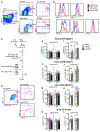B Cell Receptor Crosslinking Augments Germinal Center B Cell Selection when T Cell Help Is Limiting
- PMID: 30403996
- PMCID: PMC6289055
- DOI: 10.1016/j.celrep.2018.10.042
B Cell Receptor Crosslinking Augments Germinal Center B Cell Selection when T Cell Help Is Limiting
Abstract
Antigen-dependent engagement of germinal center (GC) B cell receptors (BCRs) promotes antigen internalization and presentation for follicular helper T cells. However, whether BCR signaling is critical or synergistic with T cell help for GC B cell selection or differentiation is unclear. Here, by adapting an experimental approach that enables independent delivery of BCR-crosslinking antigen or T cell help to GC B cells in vivo, we showed that T cell help was sufficient to induce GC B cell expansion and plasmablast formation. However, although BCR crosslinking could not by itself promote GC B cell selection or differentiation, it could synergize with T cell help to enhance the GC and plasmablast responses when T cell help was limiting. These findings indicate that GC B cells can integrate variable inputs from T cell help and BCR signaling in vivo for an optimal process of selection and differentiation, critical for potent long-term humoral immunity.
Keywords: B cell receptor; B cell selection and differentiation; T cell help; follicular helper T cells; germinal centers; plasma cells.
Copyright © 2018 The Author(s). Published by Elsevier Inc. All rights reserved.
Conflict of interest statement
DECLARATION OF INTERESTS
The authors declare no competing interests.
Figures




Similar articles
-
T Follicular Helper Cell-Germinal Center B Cell Interaction Strength Regulates Entry into Plasma Cell or Recycling Germinal Center Cell Fate.Immunity. 2018 Apr 17;48(4):702-715.e4. doi: 10.1016/j.immuni.2018.03.027. Immunity. 2018. PMID: 29669250
-
Integration of T helper and BCR signals governs enhanced plasma cell differentiation of memory B cells by regulation of CD45 phosphatase activity.Cell Rep. 2021 Aug 10;36(6):109525. doi: 10.1016/j.celrep.2021.109525. Cell Rep. 2021. PMID: 34380042 Free PMC article.
-
T-B-cell entanglement and ICOSL-driven feed-forward regulation of germinal centre reaction.Nature. 2015 Jan 8;517(7533):214-8. doi: 10.1038/nature13803. Epub 2014 Oct 15. Nature. 2015. PMID: 25317561
-
System-Level Scenarios for the Elucidation of T Cell-Mediated Germinal Center B Cell Differentiation.Front Immunol. 2021 Sep 20;12:734282. doi: 10.3389/fimmu.2021.734282. eCollection 2021. Front Immunol. 2021. PMID: 34616402 Free PMC article. Review.
-
T-cell subsets in the germinal center.Immunol Rev. 2013 Mar;252(1):146-55. doi: 10.1111/imr.12031. Immunol Rev. 2013. PMID: 23405902 Review.
Cited by
-
The Quantitative Assessment of the Secreted IgG Repertoire after Recall to Evaluate the Quality of Immunizations.J Immunol. 2020 Aug 15;205(4):1176-1184. doi: 10.4049/jimmunol.2000112. Epub 2020 Jul 15. J Immunol. 2020. PMID: 32669311 Free PMC article.
-
The AKT isoforms 1 and 2 drive B cell fate decisions during the germinal center response.Life Sci Alliance. 2019 Nov 25;2(6):e201900506. doi: 10.26508/lsa.201900506. Print 2019 Dec. Life Sci Alliance. 2019. PMID: 31767615 Free PMC article.
-
Immunization with inactivated whole virus particle influenza virus vaccines improves the humoral response landscape in cynomolgus macaques.PLoS Pathog. 2022 Oct 7;18(10):e1010891. doi: 10.1371/journal.ppat.1010891. eCollection 2022 Oct. PLoS Pathog. 2022. PMID: 36206307 Free PMC article.
-
Defective germinal center selection results in persistence of self-reactive B cells from the primary to the secondary repertoire in Primary Antiphospholipid Syndrome.Nat Commun. 2024 Nov 15;15(1):9921. doi: 10.1038/s41467-024-54228-8. Nat Commun. 2024. PMID: 39548093 Free PMC article.
-
Lung B cells in ectopic germinal centers undergo affinity maturation.Proc Natl Acad Sci U S A. 2025 Apr 8;122(14):e2416855122. doi: 10.1073/pnas.2416855122. Epub 2025 Apr 1. Proc Natl Acad Sci U S A. 2025. PMID: 40168127 Free PMC article.
References
-
- Allen CD, Okada T, Tang HL, and Cyster JG (2007). Imaging of germinal center selection events during affinity maturation. Science 315, 528–531. - PubMed
-
- Barnden MJ, Allison J, Heath WR, and Carbone FR (1998). Defective TCR expression in transgenic mice constructed using cDNA-based alpha- and beta-chain genes under the control of heterologous regulatory elements. Immunol. Cell Biol 76, 34–40. - PubMed
-
- Bonifaz L, Bonnyay D, Mahnke K, Rivera M, Nussenzweig MC, and Steinman RM (2002). Efficient targeting of protein antigen to the dendritic cell receptor DEC-205 in the steady state leads to antigen presentation on major histocompatibility complex class I products and peripheral CD8+ T cell tolerance. J. Exp. Med 196, 1627–1638. - PMC - PubMed
-
- Chan TD, Wood K, Hermes JR, Butt D, Jolly CJ, Basten A, and Brink R (2012). Elimination of germinal-center-derived self-reactive B cells is governed by the location and concentration of self-antigen. Immunity 37, 893–904. - PubMed
Publication types
MeSH terms
Substances
Grants and funding
LinkOut - more resources
Full Text Sources
Molecular Biology Databases
Miscellaneous

